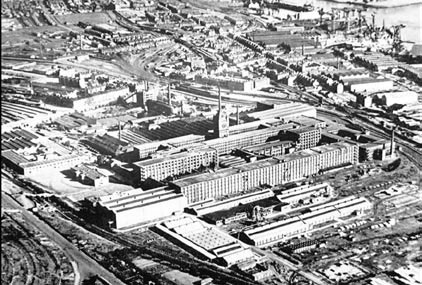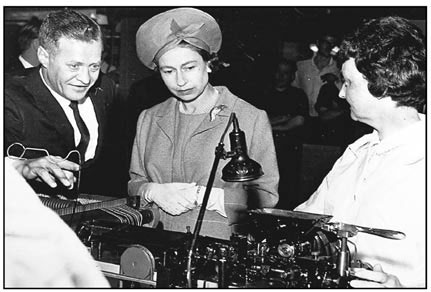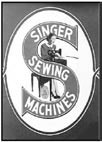The Ladies of Kilbowie had the World in Stitches
Happy memories of the world’s largest sewing machine factory
by Colin MacFarlane

Ex-Singer factory workers, Rita Kerr, Elizabeth Maitland and Mary Orr.
THINK of Clydebank and you think Blitz, John Brown’s shipyard and Singer. All three are now firmly part of the town's past, but the memories linger on, especially among the people for whom that past was their everyday lives.
Three of them - Elizabeth Maitland, Rita Kerr and Mary Off - were to be found at Clydebank Museum for the launch of A Stitch in Time, an exhibition about the history of the Singer plant.
It was in 1867 that a small assembly shop opened in Glasgow, an offshoot of I.M. Singer & Co, a sewing machine company founded by Isaac Merrit Singer in New York in 1851.
In 1882, with demand soaring for its machines, work began on the construction of the world’s largest sewing machine factory at Kilbowie, Clydebank.
The massive greenfield site and good road, rail, canal and river connections meant that eventually Singer claimed the plant manufactured 80 per cent of the world’s sewing machines.
Production peaked in 1913 when the workforce - over 16,000 at one time - produced more than 1.3 million industrial and domestic sewing machines.
Munitions
In the two world wars, as well as sewing machines the plant also made munitions such as fuses, land mines, bullets and rifle components. German bombers targeted Singer during the Clydebank Blitz in March 1941. Many buildings were destroyed by fire or bomb blasts and hundreds of workers lost their homes.
After World War 2 the plant’s fortunes gradually declined until it closed in 1980. For the people of Clydebank, it was like losing a member of the family.
Elizabeth Maitland worked for Singer as a secretary from 1961 to 1971. She said, “Singer was just like a small town with its own characters.
“There were monthly dances as well as the annual Caledonian Ball. There was the Singer Hall for events and all sorts of clubs going on, like camera clubs, pipe band, badminton clubs and football teams. It produced its own monthly magazine, the Singer Speaker.”
“When pupils from the area left school they had a choice, Singer or John Brown. There were hundreds of jobs in those days.”

The massive Singer factory was the largest of its kind in the world.
Elizabeth’s husband Alan worked for the company, as did her father-in-law and her own mum and dad.
“My father-in-law used to go to the bank on Friday morning to collect the wages. He was told to carry a truncheon in case he was robbed.”
The factory was so big it had its own fire station, with two engines. When goldfish surprisingly appeared in the canal it was discovered it was hot water pumped from the factory power station that was making it habitable.
Elizabeth recalled, “When they were cleaning out the canal years after the factory closed, they found many faulty sewing machine parts that had been dumped. Whoever discarded them obviously didn't want their foreman finding out they’d made a mistake.”
Singer also had its own train station, which is all that’s left as a reminder of the factory.
Elizabeth smiled, “Some of the men taking the train from Singer station used to sneak a table-top from a sewing machine on board so they could have a game of cards on the way home. Everything was made for the sewing machines at Clydebank, from the wooden cabinets to all the parts.”
Motors

The Queen opened a new assembly line at the factory in 1965.
“Department 47 was known as ‘the beauty parlour’. They made the motors there and it was staffed totally by women. Of course that was the department all the men wanted to visit.”
Elizabeth, who now lives in Bearsden, was the last Singer Gala Queen.
“That was in 1965, when I was 18. I was crowend on the Singer playing field and driven away in a horse and carriage.”
“Gala day was a massive event, with thousands taking part.” Rita Kerr (87), from Hardgate, worked in production for 26 years. She said, “I was an electric buffer and had to buff 130 sewing machines a day. The buffer could give you a sore burn if you weren’t careful. But Singer was a happy place to work. When the Queen visited the factory in 1965 to open a new assembly line, Rita buffed up the sewing machine presented to Her Majesty.
Her husband, Sam, two daughters and her' daughter-in-law also worked for Singer.
“There were plenty of characters. We had a security man we called Plum, an ex policeman. He would search your bag when you were leaving and try to catch the men smoking in places they shouldn’t. I remember a painter was told to paint the room behind the canteen with a coat of blue paint and to ‘Mind the piano,’ meaning don’t splash any paint on it. When the foreman came back, the man had painted the piano blue as well!”
“We weren’t allowed animals but we sneaked in a wee white cat we called Cheeky. We would all chip in a shilling a week to pay for its food and if it needed to see a vet. Even the men donated. On the Friday before we broke up for the fair holiday, the first two weeks in July, everyone would bring in sandwiches and cakes, and a wee drink of course, then queue up for their holiday pay.”
Mary Orr, from High Dalmuir, was at Singer from 1962 to 1979, starting at 15 as a messenger and eventually becoming a secretary to one of the directors.
She said, “It was a sight, seeing the thousands coming down Kilbowie Road looking at the Singer clock to see if they were on time. I remember the day in 1963 the clock was stopped to be taken down, before the tower was demolished during rebuilding. Some men and women were openly crying.”
“My friend from school, Helen Heggie, had started with me and we would do our messages together. One department had an immaculate floor and the manager there would let me and Helen dance to my transistor radio. We’d dance the Twist and we’d be clapped by the men and women working there when we finished. We used to sunbathe on one of the roofs at lunchtimes in summer. One day it was really hot and our clothes got stuck to the melting hot tar. We had to pull each other free.”

alt="The Singer Sewing Machine Company S Logo" title="The Singer Sewing Machine Company S Logo">
Marriages
“There were plenty of marriages made in Singer. The bride-to-be would have her coat done up with streamers and balloons and be given a baby's potty, filled with salt for good luck. She was then paraded up the main road by her pals.”
Sadly, those happy days for the three Singer women were not so happy for the plant. It struggled against a host of new European competitors and a growing threat from Japan. Despite substantial investment in the 1960s, the factory struggled to keep profits up.
Singer invested in other European and Far Eastern plants to produce more popular domestic models. Between 1960 and 1970, the Kilbowie workforce declined from over 16,000 to just 6400.
In 1978, Singer proposed a reduction from 4800 workers to just 2000. A collapse in worker morale, difficulties in negotiations between company and unions, and Margaret Thatcher’s victory at the 1979 General Election didn’t help.
On October 12 Singer announced the factory would close in June 1980 “as part of a sweeping programme to restructure, consolidate and streamline Singer manufacturing and marketing operations.”
The Scottish Development Agency bought the Kilbowie site and the old factory buildings were demolished to make way for the new Clydebank Business Park with financial inducements for companies to set up or move there.
Singer provided one of the first tenants - the firm opened an office employing only six people. But Elizabeth Maitland at least has more than just memories of the good old days.
She smiled, “I’ve still got my Singer sewing machine and it still works well.”
Reprinted from The Sunday Post (Scotland).
© D.C. Thompson Ltd. Used with permission/em>





